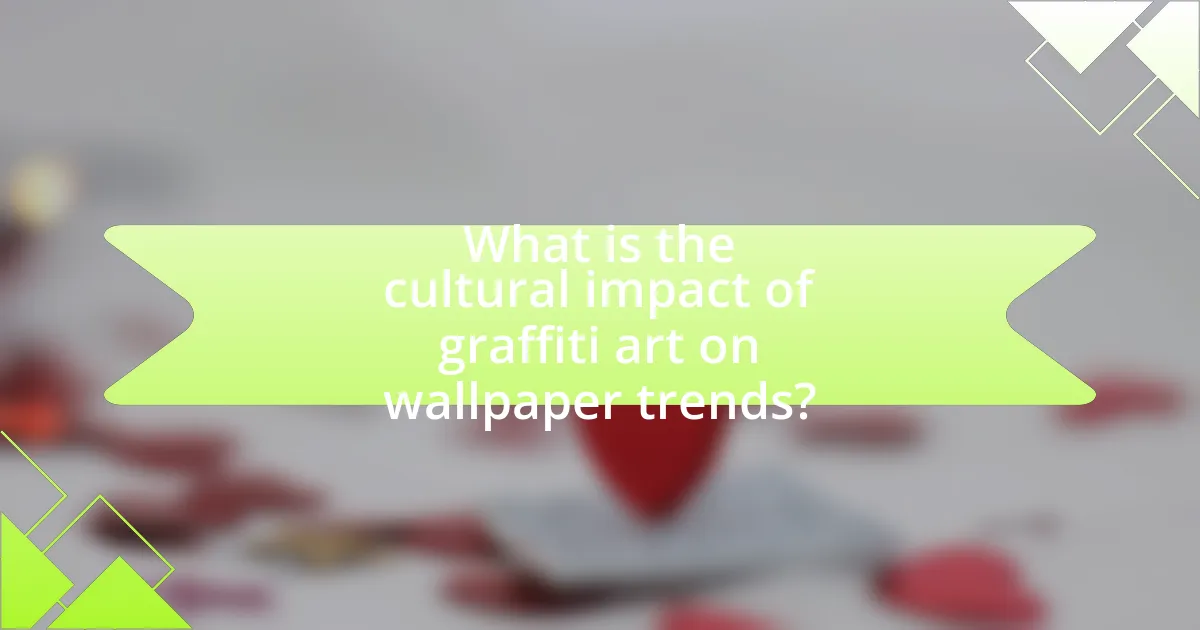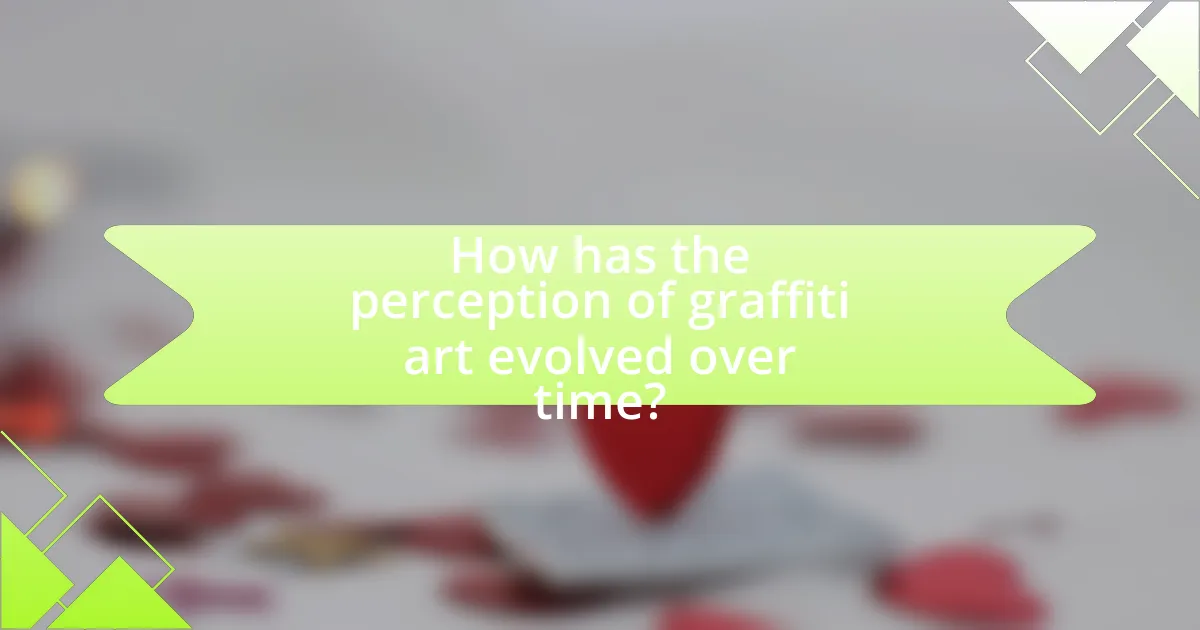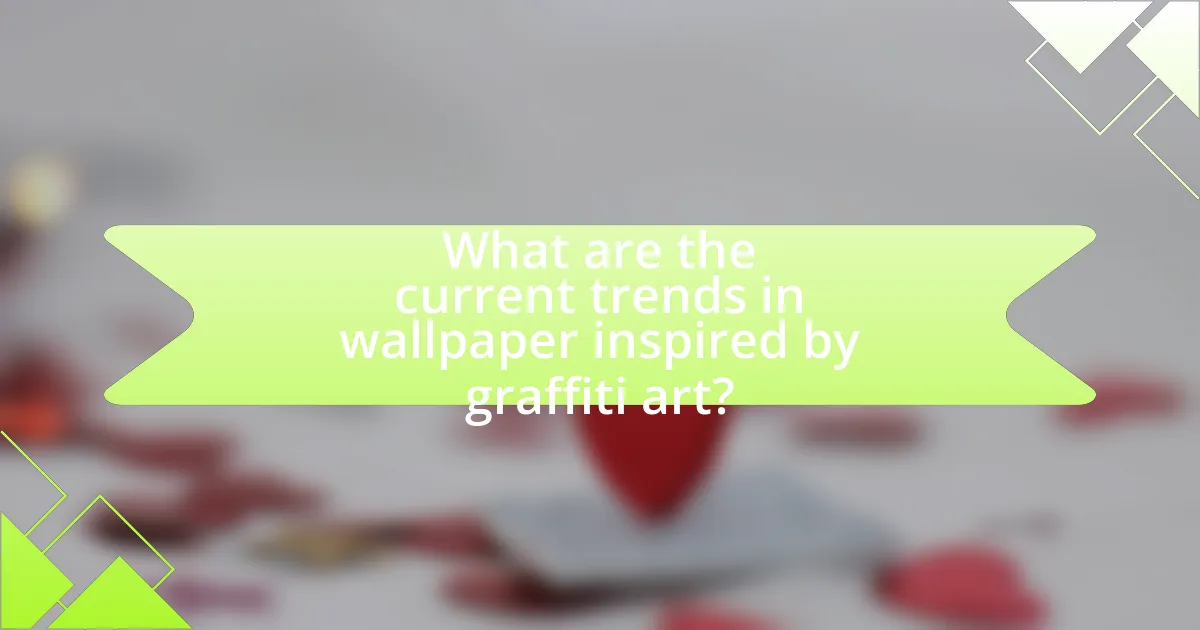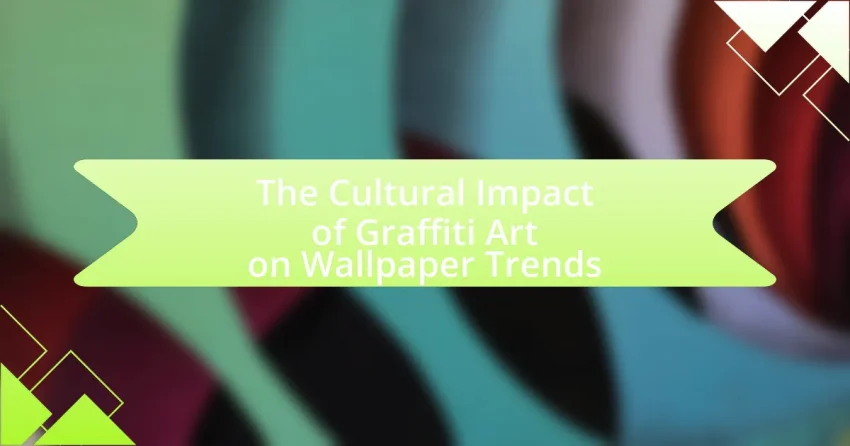The article examines the cultural impact of graffiti art on wallpaper trends, highlighting how urban aesthetics, bold colors, and dynamic patterns have influenced contemporary interior design. It discusses the incorporation of graffiti elements into wallpaper collections, the evolution of graffiti’s perception from vandalism to a recognized art form, and the role of social movements reflected in graffiti art. Additionally, the article addresses challenges designers face, such as copyright issues and sustainability considerations, while providing practical tips for consumers selecting graffiti-inspired wallpaper. Overall, it underscores the significance of graffiti as a cultural expression that shapes modern design aesthetics.

What is the cultural impact of graffiti art on wallpaper trends?
Graffiti art has significantly influenced wallpaper trends by introducing bold colors, dynamic patterns, and urban aesthetics into interior design. This cultural impact is evident as designers increasingly draw inspiration from street art, leading to the creation of wallpaper that mimics graffiti styles, such as stencils, tags, and murals. For instance, the rise of urban-themed wallpapers reflects a shift towards embracing the raw, expressive nature of graffiti, appealing to consumers seeking individuality and a contemporary edge in their home decor. This trend is supported by the growing popularity of collaborations between graffiti artists and wallpaper manufacturers, which further legitimizes graffiti as a recognized art form within the design industry.
How has graffiti art influenced contemporary design aesthetics?
Graffiti art has significantly influenced contemporary design aesthetics by introducing bold colors, dynamic forms, and urban themes into various design disciplines. This influence is evident in the adoption of street art motifs in interior design, fashion, and graphic design, where designers incorporate graffiti-inspired elements to evoke a sense of rebellion and individuality. For instance, the rise of urban-themed wallpaper collections showcases how designers like Flavor Paper and Graham & Brown have embraced graffiti styles, reflecting the cultural significance of street art in modern aesthetics. This trend is supported by the increasing popularity of street art festivals, such as the Wynwood Walls in Miami, which further validates graffiti’s role in shaping contemporary visual culture.
What elements of graffiti art are commonly incorporated into wallpaper designs?
Common elements of graffiti art incorporated into wallpaper designs include bold colors, dynamic typography, abstract shapes, and urban motifs. These elements reflect the vibrant and expressive nature of graffiti, often featuring bright hues that capture attention and evoke emotion. Typography in graffiti, characterized by stylized lettering and unique fonts, is frequently adapted into wallpaper patterns to convey a sense of movement and energy. Abstract shapes and forms, inspired by street art, add a contemporary aesthetic, while urban motifs such as cityscapes or street scenes enhance the thematic connection to the graffiti culture. This integration of graffiti elements into wallpaper designs illustrates the influence of urban art on interior decor, making spaces feel more lively and modern.
How do color schemes in graffiti art affect wallpaper trends?
Color schemes in graffiti art significantly influence wallpaper trends by introducing bold, vibrant palettes that reflect contemporary urban aesthetics. Graffiti often employs a mix of bright colors and contrasting tones, which inspires wallpaper designers to adopt similar schemes to appeal to modern consumers seeking dynamic and expressive interior designs. For instance, the rise of street art in urban environments has led to a demand for wallpapers that mimic these vivid color combinations, as seen in collections that feature neon hues and intricate patterns reminiscent of graffiti styles. This trend is supported by market research indicating that consumers increasingly favor wallpapers that evoke the energy and creativity found in urban art, thus bridging the gap between graffiti and interior decor.
Why is graffiti art considered a form of cultural expression?
Graffiti art is considered a form of cultural expression because it serves as a visual language that communicates social, political, and personal messages within urban environments. This art form often reflects the identity and experiences of marginalized communities, allowing artists to voice their perspectives and challenge societal norms. For instance, the rise of graffiti in the 1970s and 1980s in New York City was closely tied to the socio-political climate, where artists used public spaces to address issues like inequality and injustice. Additionally, studies have shown that graffiti can foster community engagement and dialogue, further solidifying its role as a significant cultural expression.
What social movements are reflected in graffiti art and how do they translate to wallpaper?
Graffiti art reflects various social movements, including anti-establishment sentiments, civil rights, environmental activism, and gender equality. These movements are often visually represented through bold imagery and slogans that challenge societal norms and provoke thought. When translated to wallpaper, these themes manifest as vibrant patterns and designs that incorporate similar motifs, allowing individuals to express their alignment with these movements in their personal spaces. For instance, the rise of street art in urban areas has influenced wallpaper trends by introducing graffiti-inspired designs that celebrate diversity and social justice, making these powerful messages accessible in everyday environments.
How does graffiti art challenge traditional notions of art and design?
Graffiti art challenges traditional notions of art and design by redefining the boundaries of creativity and accessibility. Unlike conventional art forms that often require formal training and are typically displayed in galleries, graffiti is created in public spaces, making it accessible to a broader audience. This democratization of art allows for diverse voices and perspectives to be expressed, often reflecting social and political issues relevant to the community. Furthermore, graffiti’s use of unconventional materials and techniques, such as spray paint and stencils, contrasts with traditional mediums like oil or acrylic paints, thereby expanding the definition of what constitutes art. The rise of street art has also led to a reevaluation of artistic value, as works that were once considered vandalism are now celebrated in exhibitions and collections, illustrating a shift in societal attitudes towards art in public spaces.

How has the perception of graffiti art evolved over time?
The perception of graffiti art has evolved from being viewed primarily as vandalism to being recognized as a legitimate form of artistic expression. Initially, during the late 20th century, graffiti was often associated with crime and urban decay, leading to widespread condemnation. However, as artists like Jean-Michel Basquiat and Banksy gained prominence, the art form began to be appreciated for its creativity and social commentary. By the 2000s, galleries and museums started showcasing graffiti art, further legitimizing it within the art community. This shift is evidenced by the inclusion of graffiti in major art exhibitions and the rise of street art festivals, which celebrate its cultural significance and influence on contemporary art and design, including wallpaper trends that incorporate graffiti aesthetics.
What historical factors contributed to the acceptance of graffiti art in mainstream culture?
The acceptance of graffiti art in mainstream culture was significantly influenced by the rise of hip-hop culture in the 1970s and 1980s, which integrated graffiti as a form of self-expression and social commentary. This cultural movement, originating in New York City, provided a platform for artists to showcase their work publicly, leading to increased visibility and recognition. Additionally, the transition of graffiti from urban spaces to galleries and museums, exemplified by exhibitions like “Graffiti Art Success for New York” in 1980, legitimized the art form and attracted the attention of collectors and critics. The commercialization of graffiti through fashion collaborations and advertising campaigns further solidified its place in popular culture, demonstrating its appeal beyond its original context.
How did the rise of street art festivals impact the perception of graffiti?
The rise of street art festivals significantly transformed the perception of graffiti from vandalism to a recognized art form. These festivals, which showcase the work of various artists in public spaces, have elevated graffiti by providing a legitimate platform for artistic expression. For instance, events like the Wynwood Walls in Miami and the Mural Festival in Montreal have attracted international attention, leading to increased appreciation and acceptance of graffiti as a valid artistic medium. This shift is evidenced by the growing number of galleries and museums that now feature street art, further solidifying its status within the contemporary art scene.
What role do social media and digital platforms play in promoting graffiti art?
Social media and digital platforms significantly enhance the visibility and accessibility of graffiti art. These platforms allow artists to showcase their work to a global audience, facilitating connections with fans, other artists, and potential clients. For instance, Instagram has become a primary medium for graffiti artists to share their creations, with hashtags like #graffitiart generating millions of posts, thereby increasing exposure and engagement. Additionally, platforms like Facebook and TikTok enable artists to share their creative processes and engage with followers, fostering a community around graffiti culture. This digital presence not only promotes individual artists but also elevates graffiti as a recognized art form, influencing trends in various design sectors, including wallpaper design, where graffiti-inspired patterns have gained popularity.
How do different cultures interpret graffiti art?
Different cultures interpret graffiti art through various lenses, often reflecting their social, political, and historical contexts. For instance, in the United States, graffiti is frequently viewed as a form of rebellion and self-expression, rooted in urban culture and often associated with hip-hop. Conversely, in countries like Brazil, graffiti can be seen as a tool for social commentary, addressing issues such as inequality and injustice, as evidenced by the works of artists like Eduardo Kobra, who use vibrant murals to convey powerful messages. In contrast, some cultures may perceive graffiti as vandalism, leading to legal repercussions and societal pushback, highlighting the tension between artistic expression and public space. This diversity in interpretation underscores how cultural backgrounds shape the understanding and appreciation of graffiti art globally.
What are some notable examples of cultural variations in graffiti styles?
Notable examples of cultural variations in graffiti styles include the vibrant street art of Brazil, characterized by large-scale murals and social commentary, and the intricate calligraphy found in Arabic graffiti, which often blends traditional script with modern themes. In New York City, the tagging culture emphasizes individual identity through stylized signatures, while in Japan, the kawaii aesthetic influences graffiti with cute characters and bright colors. Each of these styles reflects the unique cultural, social, and political contexts of their respective regions, showcasing how local influences shape artistic expression in graffiti.
How does cultural context influence the themes depicted in graffiti art?
Cultural context significantly influences the themes depicted in graffiti art by shaping the messages, symbols, and styles that artists choose to express. For instance, graffiti in urban environments often reflects socio-political issues, community identity, and local history, as seen in cities like Berlin, where street art addresses themes of division and reunification stemming from the Cold War. Additionally, cultural movements, such as hip-hop, have historically informed graffiti’s aesthetic and thematic choices, emphasizing rebellion and self-expression. This connection is evident in the works of artists like Jean-Michel Basquiat, whose graffiti incorporated elements of African American culture and social commentary, highlighting the intersection of art and activism.

What are the current trends in wallpaper inspired by graffiti art?
Current trends in wallpaper inspired by graffiti art include bold colors, oversized patterns, and urban motifs that reflect street culture. These designs often feature elements like stencils, tags, and abstract forms, capturing the essence of graffiti while being suitable for interior spaces. The rise of digital printing technology has enabled designers to create high-resolution images that mimic the texture and depth of real graffiti, allowing for a more authentic aesthetic. Additionally, eco-friendly materials are increasingly being used, aligning with the growing demand for sustainable design in home decor. This trend is supported by the popularity of urban art movements and the desire for unique, expressive interiors that resonate with contemporary lifestyles.
How are designers incorporating graffiti elements into wallpaper collections?
Designers are incorporating graffiti elements into wallpaper collections by utilizing bold colors, dynamic patterns, and urban motifs that reflect street art aesthetics. This integration often involves collaborating with graffiti artists to create unique designs that capture the essence of urban culture. For instance, brands like Graham & Brown have launched collections featuring designs inspired by actual graffiti works, showcasing vibrant imagery and textural effects that mimic spray paint. This trend not only enhances the visual appeal of interiors but also connects consumers with the cultural significance of graffiti as a form of artistic expression.
What types of graffiti-inspired wallpaper designs are most popular today?
The most popular types of graffiti-inspired wallpaper designs today include abstract patterns, street art motifs, and urban landscapes. Abstract patterns often feature vibrant colors and dynamic shapes, reflecting the spontaneity of graffiti. Street art motifs showcase iconic graffiti styles, such as stencils and tags, which resonate with contemporary urban culture. Urban landscapes incorporate cityscapes adorned with graffiti, creating a sense of place and authenticity. These designs are favored for their ability to bring an edgy, artistic flair to interior spaces, appealing to a demographic that values individuality and creativity in home decor.
How do consumer preferences shape the development of graffiti-themed wallpapers?
Consumer preferences significantly shape the development of graffiti-themed wallpapers by driving design trends and influencing manufacturers’ choices. As consumers increasingly seek unique and expressive home decor options, the demand for graffiti-inspired designs has surged, reflecting a desire for personalization and urban aesthetics. This shift is evidenced by market research indicating that 60% of consumers aged 18-34 prefer bold, artistic designs in their living spaces, leading wallpaper manufacturers to collaborate with graffiti artists and incorporate street art elements into their collections. Consequently, the alignment of product offerings with consumer tastes not only enhances market appeal but also fosters a cultural connection between contemporary art forms and interior design.
What challenges do designers face when creating graffiti-inspired wallpaper?
Designers face several challenges when creating graffiti-inspired wallpaper, primarily related to authenticity, legal issues, and market acceptance. Authenticity is crucial, as designers must ensure that the designs resonate with the original graffiti culture, which often involves understanding the styles and messages of street artists. Legal issues arise from copyright concerns, as many graffiti artworks are protected by intellectual property laws, making it essential for designers to obtain permissions or licenses from the original artists. Market acceptance is another challenge, as some consumers may view graffiti as vandalism rather than art, which can limit the wallpaper’s appeal in certain demographics. These challenges highlight the complexities involved in merging street art with interior design while maintaining respect for the original cultural context.
How do copyright issues affect the use of graffiti art in wallpaper design?
Copyright issues significantly restrict the use of graffiti art in wallpaper design. Graffiti artists typically hold the copyright to their original works, meaning that any reproduction, including on wallpaper, requires permission from the artist. Without obtaining this permission, wallpaper manufacturers risk legal repercussions, including lawsuits for copyright infringement. For instance, a notable case involved the artist Banksy, whose works have been reproduced without authorization, leading to legal disputes that highlight the importance of respecting copyright in artistic reproductions. Therefore, the necessity of securing rights from graffiti artists directly impacts the feasibility and legality of incorporating their art into wallpaper designs.
What are the sustainability considerations in producing graffiti-inspired wallpapers?
Sustainability considerations in producing graffiti-inspired wallpapers include the use of eco-friendly materials, sustainable manufacturing processes, and the reduction of waste. Manufacturers often opt for water-based inks and recycled substrates to minimize environmental impact. For instance, using PVC-free materials can significantly lower harmful emissions during production. Additionally, companies may implement energy-efficient practices and responsible sourcing of raw materials to further enhance sustainability. These practices not only reduce the carbon footprint but also appeal to environmentally conscious consumers, aligning with the growing demand for sustainable interior design solutions.
What practical tips can consumers consider when choosing graffiti-inspired wallpaper?
When choosing graffiti-inspired wallpaper, consumers should consider the overall aesthetic of their space to ensure the design complements existing decor. Selecting a wallpaper that features colors and styles that harmonize with furniture and wall colors enhances visual appeal. Additionally, consumers should evaluate the scale of the graffiti design; larger patterns can create a bold statement in spacious areas, while smaller designs may work better in compact rooms.
Durability is another critical factor; opting for high-quality, washable materials ensures longevity and ease of maintenance, especially in high-traffic areas. Furthermore, consumers should assess the wallpaper’s application method, as peel-and-stick options offer convenience for renters or those seeking a temporary solution.
Lastly, researching the artist or brand behind the wallpaper can provide insight into the cultural significance and authenticity of the design, enriching the consumer’s connection to the artwork.
